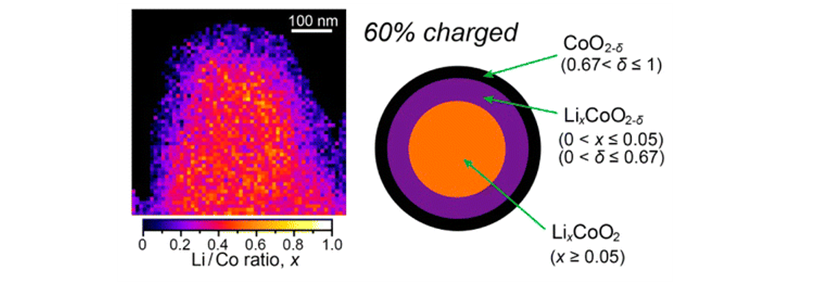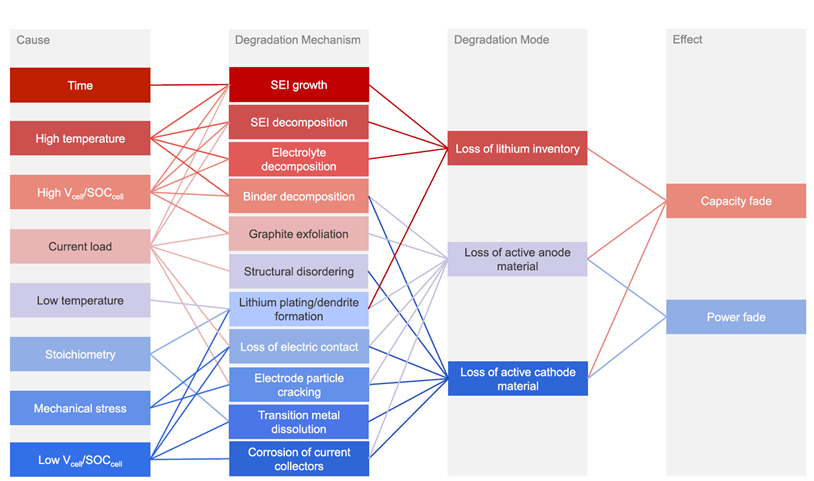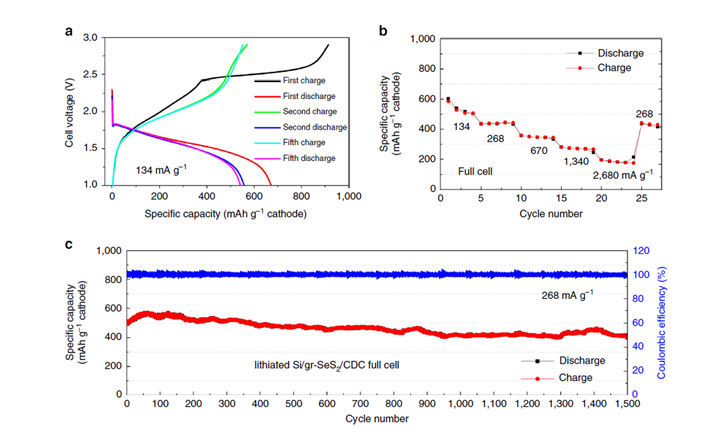| WPM 고성능 이차전지소재 사업단 소식지 | 2017.02 |
기술정보
NCA 양극활물질에 대한 나노수준 바나듐 처리의 고온에서의 역할
 |
| Fig. 1 (a) XPS spectra of VNCA; carbon (the peak at 284.4 eV draws a distinction between the standard carbon and the carbon background), (e) Plot of pH vs. measuring time in a mixture of BNCA or VNCA powders and water. |
 |
|
Fig. 2 (a) Cycling performances of BNCA and VNCA cathodes in lithium half-cells (2032R) during 200 cycles at 1C rate (equivalent to 210 mA g-1) at 60 ℃. (b) Discharge curves of BNCA and VNCA cathodes at 1C rate discharge after being stored at 4.3V for 10h and 1 week at 60 ℃. (c) Rate capabilities of BNCA and VNCA cathodes at the same charge and discharge C-rates of 0.1 C and 0.2 C, and 0.5 C charge C-rate for higher than or equal to 0.5 C discharge Crate at 24 C.
|
 |
| Fig. 3 (a) Differential scanning calorimetry of BNCA and VNCA charged at 4.3V and (b) contour plots of in situ HT-XRD of (b) BNCA and (c) VNCA after charging at 4.3V. |
- Title : The role of nanoscale-range vanadium treatment in LiNi0.8Co0.15Al0.05O2 cathode materials for Li-ion batteries at elevated temperatures Journal of Materials Chemistry A, 2015, 3, 13453
- Ni 함량이 80 %에 달하는 Ni-rich 양극 활물질 중 하나인 LiNi0.8Co0.15Al0.05O2(NCA) 의 표면에 나노 수준의 바나듐 처리를 통하여 pH와 잔존 리튬을 감소시키면서 수명, 율, 저장 시 우수한 전기화학 특성을 발현할 수 있는 연구 결과가 유명한 학술지 중 하나인 JMCA에서 소개되었다. - V-treated NCA(VNCA)는 NCA를 65 ℃에서 1시간 동안 에탄올에 녹인 NH4VO3에 110 ℃로 교반하면서 증발시킨 후 400℃로 열처리하여 만들어진다. VNCA는 NCA 표면의 활물질에 남아있는 잔존 리튬과 반응하여 LixVOy 형태의 화합물이 만들어지며, 표면에서 벌크로 15 nm 수준의 도핑 형태로 처리된다. VNCA를 XPS 분석으로 확인했을 때 BNCA보다 Li2CO3 피크 강도가 확연한 차이로 감소하였으며, 각 활물질을 1시간 동안 교반시켰을 때 pH 수준 또한 12 이상의 BNCA보다 낮은 11.5에 수렴하는 것을 확인할 수 있다. - 60 ℃ 조건 하에 3.0 – 4.3 V 전압 범위에서 1 C-rate로 200 cycle 동안 수명 특성 평가를 진행한 결과, BNCA(78 %)보다 우수한 VNCA(90 %)의 방전용량 유지율을 확인할 수 있었다. 또한 60 ℃에서 4.3 V 충전 상태로 10시간, 1주일로 BNCA, VNCA 전극에 대한 저장 특성을 확인한 결과, VNCA가 BNCA에 비해 저장 후에도 상대적으로 우수한 용량 유지율을 보여주었다. 이것은 일반적으로 전극 표면에 대한 HF 공격으로 전이금속 용출이 발생할 수 있는 부분에 대한 바나듐 표면 처리의 효과라 할 수 있다. 60 ℃에서 진행한 율특성 평가 또한 마찬가지로 고율로 진행될수록 VNCA가 BNCA 보다 우수한 성능을 나타내었다. |
Chemical States of overcharged LiCoO2 particle surfaces and interiors observed using Electron Energy-Loss Spectroscopy
 |
| 그림 Demonstration of direct evidence of inhomogeneity of chemical states in LCO single particle |
| - Title: Chemical States of overcharged LiCoO2 particle surfaces and interiors observed using Electron Energy-Loss Spectroscopy 일본 Hitachi의 Hitachi Research Laboratory에서 기존 리튬이차전지 양극소재로 쓰이고 있는 LiCoO2의 불분명한 열화 메커니즘 규명할 수 있는 가능성을 제시하였다고 2015년 7월 The Journal of Physical Chemistry C에 발표하였다. - 연구팀은 일반적으로 고전압에서 많은 양의 리튬이 탈리되면 쉽게 열화되는 LiCoO2 양극 활물질의 열화 메커니즘의 중요한 요인이 무엇인지 밝혀냈다. 이번 연구는 LiCoO2의 입자 레벨에서의 화학적인 분석을 통해 진행되었다. 일반적으로 입자를 구성하는 원소와 그 원소의 산화수 분석을 높은 분해능으로 가능케하는 EELS(Electron Energy-Loss Spectroscopy)의 Li-K, Co-M2,3, Co-L3, O-K edges의 분석을 통해 LiCoO2 입자의 Li과 Co의 상대적인 양에 대한 맵핑을 진행하였고 또한 특정 구역에 존재하는 상을 예측할 수 있었다. 이를 통해 양극 활물질의 충전상에 대한 일차 입자 기준으로 Li의 불균일성을 확인할 수 있었고, 표면에서부터 입자 안쪽까지 존재하는 상에 대한 불균일성 또한 확인하였다. 이는 고전압에서의 양극 활물질의 열화 메커니즘을 규명할 수 있는 핵심 포인트가 될 것으로 예상된다. 이 기술을 활용하면 기존의 리튬이차전지 양극 소재로 활용되는 다양한 전이금속 산화물의 입자 전반적은 Li의 양을 가시화할 수 있을 것이고 Li의 불균일성을 다른 양극 소재에서도 확인할 수 있는 중요한 기술로 활용될 수 있다고 밝혔다. (The Journal of Physical Chemistry C , 2015) |
Degradation diagnostics for lithium ion cells
 |
| Power Sources 341 (2017) 373e386] Degradation in lithium ion (Li-ion) battery cells is the result of a complex interplay of a host of different physical and chemical mechanisms. The measurable, physical effects of these degradation mechanisms on the cell can be summarised in terms of three degradation modes, namely loss of lithium inventory, loss of active positive electrode material and loss of active negative electrode material. The different degradation modes are assumed to have unique and measurable effects on the open circuit voltage (OCV) of Li-ion cells and electrodes. The presumptive nature and extent of these effects has so far been based on logical arguments rather than experimental proof. This work presents, for the first time, experimental evidence supporting the widely reported degradation modes by means of tests conducted on coin cells, engineered to include different, known amounts of lithium inventory and active electrode material. Moreover, the general theory behind the effects of degradation modes on the OCV of cells and electrodes is refined and a diagnostic algorithm is devised, which allows the identification and quantification of the nature and extent of each degradation mode in Li-ion cells at any point in their service lives, by fitting the cells' OCV. |
Silicon과 selenium의 상호보완적 화학결합을 이용한 silicon-chalcogen 배터리
 |
| Figure 1. Electrochemical performances of the newly designed full cell employing lithiated Si/graphene anode and SeS2/CDC cathode. The full cell was tested between 1.0 and 2.85 V at the charge/discharge rates from 134 to 2,680 mA g-1SeS2 at 20°C. (a) The charge/discharge curves during the first five formation cycles. (b) The rate capability with an increase in charge/discharge rate from 134 to 2,680 mA g-1SeS2 and then a decrease to 134 mA g-1SeS2. (c) The CR and CE at 268 mA g-1SeS2 for 1,500 cycles. |
 |
| Figure 2. Schematic of the in-situ formation of hierarchically structured nano-Si particles with Se-containing SEI layer. During the LiB cycles, micro-sized Si particles are pulverized to nano-sizes. Then, the formation of general low-conductive SEI leads to continuous growth of SEI on the pulverized surface and then induces a large increase in resistance and loss of the cyclable lithium ions, resulting in rapid capacity decay (isolation of active material). In contrast, when the cathode material has Se or Se compounds (SeSx), the dissolved Se ions from cathode becomes an essential component of SEI (hierarchical layer structure).The highly conductive SEI can keep the Li ion/electron transfer between electrolyte and active materials fast and hence impede an unnecessary SEI growth on the surface and the isolation of the pulverized Si particles into the non-electrochemically active area. |
- Title: A stable lithiated silicon-chalcogen battery via synergetic chemical coupling between silicon and selenium - 광주과학기술원(GIST)과 미국 Georgia institute of technology 등의 공동연구팀은 lithiated Si/graphene 음극과 selenium disulfide(SeS2)/carbide-derived carbon(CDC) 양극으로 완전셀을 조립하여 테스트 하였다. 그 결과 초기효율은 73.5%를 나타내었고 이 후 5사이클 동안 98.1%까지 회복한 후 눈에 띄는 용량 감소는 나타나지 않았다.(Figure 1a) - 완전셀의 율특성 평가 결과 2C에서 175 ~ 195 mAh g-1SeS2의 안정된 용량을 보이며, 율특성 평가 이후 0.2C로 속도를 낮추어 충방전한 결과 0.2C의 원래 용량인 441 mAh g-1SeS2으로 완전히 회복되었다.(Figure 1b) 그리고 1500 사이클 동안 403 mAh g-1SeS2 이상의 높은 용량, 81%의 용량 유지율과 평균 99.99%의 효율을 나타냈다. (Figure 1c) - 본 연구에서 사용한 양극 물질은 Se 또는 Se화합물(SeSx)을 포함하고 있으며, 양극으로부터 용해된 Se가 SEI의 구성물로 참여해 Li 이온 및 전자의 전달 특성을 향상시키는 역할을 한다. 결과적으로 Si 표면에 과도한 SEI 성장 및 미분화된 Si 입자의 전기적 단락을 방지하여 전지특성 향상에 도움을 줄 수 있다고 설명하고 있다. (Figure 2) 자료출처: Nature Communications, 13888(2017) doi:10.1038/ncomms13888 |
본 메일은 발신전용입니다. 문의사항은 eunmi.kang@samsung.com으로 문의하십시오.
COPYRIGHT(C) 2013. SAMSUNG SDI INC. ALL RIGHT RESERVED.